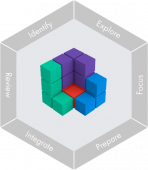Why did we include a Foundation Course in the Great Teaching Toolkit?
The Great Teaching Toolkit is a new approach to professional development, and the Foundation Course is the first step of this professional development journey. When we were designing the GTT, we knew that if we wanted teachers and school leaders to get the most out of the resources we were putting at their fingertips, we’d need to support them to make decisions that were best for their context. Which of the tools should they use? When would be most appropriate? How will they help improve their practice? The Foundation Course is designed to answer all of these questions!
A curriculum for teacher professional development
The Foundation Course starts by introducing our evidence-based Model for Great Teaching – our best attempt to package up what great teachers do, know and believe.
It would be a routine expectation in most schools and colleges to provide students with a sequenced curriculum that maps out essential learning aims; but this rarely happens with teacher professional development. For teachers who want to get better at teaching, the four Dimensions and 17 Elements in the Model for Great Teaching provide a list of the specific areas that are “best bets” to develop, based on what we know from the best available research evidence.
Practical guidance to develop evidence-based practice

One of the main features of the Great Teaching Toolkit is the built-in time for teachers to reflect on their own classrooms and practise strategies that they’ve selected, appropriate for their context. The Foundation Course sets out an evidence-based approach for teachers to get even better, over time. They begin by identifying an element to work on improving, perhaps by using one of the student survey or video observation tools. The other GTT courses can help teachers to explore that element in more details, before guiding them to focus on their own classroom practice, and prepare a development plan for what they’ll do next. All that’s left is to integrate what they’ve learnt into everyday teaching, making sure review points are built in to know whether it’s having the desired impact.
Creating a common language about learning
The aim of Great Teaching is learning, so the Foundation Course also encourages teachers to take some time to think deeply about what it is, and how it happens. The second section of the course discusses the mechanisms and principles that govern how learning happens, focusing on the cognitive basis for learning and memory.
This is designed so that all teachers secure a solid foundation of theory from research evidence in cognitive neuroscience and cognitive psychology that will help them select and adapt evidence-based strategies effectively, no matter how they go about using the GTT. Having this shared understanding – not only about how our students learn, but how we can ensure we have the conditions optimised for teacher learning – facilitates meaningful conversations in a shared language about great teaching and student learning.
We practise what we preach
The Foundation Course is also an opportunity to demonstrate the evidence-based practices we promote throughout the Great Teaching Toolkit. There is compelling evidence around the impact of collaboration on teacher professional learning (Sims & Fletcher-Wood, 2021; Timperley et al., 1997), therefore we provide discussion tasks to have with colleagues, irrespective whether they’re also using the GTT. We also introduce our GTT Community, an online discussion forum for teachers to share their ideas with colleagues around the world.
We also know the importance of the act of retrieval in embedding learning (e.g., Karpicke & Roediger, 2008; Agarwal et al., 2012; Soderstrom et al, 2016). By attempting to retrieve knowledge, we activate associations to other related pieces of information, to the context in which we learned the information originally, and perhaps to other retrieval instances. Making connections to both other concepts and to the learning context contribute to embedding the knowledge more effectively into long-term memory. The Foundation Course contains retrieval questions spaced throughout, to help forge those mental connections and demonstrate the regular retrieval that teachers should expect as they work through the GTT.
Find out more
The Foundation Course is a valuable tool for any teacher on the Great Teaching Toolkit. We believe it is also filled with useful information and practical considerations for any teacher who wishes to improve their practice. Therefore, we’ve made the entire course available to anyone who signs up for a free GTT starter account.
Join today and discover the Foundation Course for yourself!
References
Agarwal, P. K., Bain, P. M., & Chamberlain, R. W. (2012). The value of applied research: Retrieval practice improves classroom learning and recommendations from a teacher, a principal, and a scientist. Educational Psychology Review, 24(3), 437–448. doi:10.1007/s10648-012-9210-2
Karpicke, J. D., & Roediger, H. L. (2008). The critical importance of retrieval for learning. Science, 319(5865), 966–968. doi: 10.1126/science.1152408
Sims, S., & Fletcher-Wood, H. (2021). Identifying the characteristics of effective teacher professional development: a critical review. School Effectiveness and School Improvement, 32(1), 47–63. doi:10.1080/09243453.2020.1772841
Soderstrom, N. C., Kerr, T. K., & Bjork, R. A. (2016). The critical importance of retrieval—and spacing—for learning. Psychological Science, 27(2), 223–230. doi: 10.1177/0956797615617778
Timperley, H., Wilson, A., Barrar, H., & Fung, I. (2007). Teacher professional learning and development. 344. http://educationcounts.edcentre.govt.nz/goto/BES





